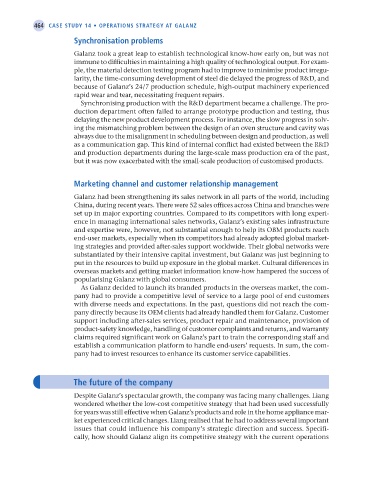Page 489 - Operations Strategy
P. 489
464 case study 14 • OperatiOns strategy at galanz
synchronisation problems
Galanz took a great leap to establish technological know-how early on, but was not
immune to difficulties in maintaining a high quality of technological output. For exam-
ple, the material detection testing program had to improve to minimise product irregu-
larity, the time-consuming development of steel die delayed the progress of R&D, and
because of Galanz’s 24/7 production schedule, high-output machinery experienced
rapid wear and tear, necessitating frequent repairs.
Synchronising production with the R&D department became a challenge. The pro-
duction department often failed to arrange prototype production and testing, thus
delaying the new product development process. For instance, the slow progress in solv-
ing the mismatching problem between the design of an oven structure and cavity was
always due to the misalignment in scheduling between design and production, as well
as a communication gap. This kind of internal conflict had existed between the R&D
and production departments during the large-scale mass production era of the past,
but it was now exacerbated with the small-scale production of customised products.
Marketing channel and customer relationship management
Galanz had been strengthening its sales network in all parts of the world, including
China, during recent years. There were 52 sales offices across China and branches were
set up in major exporting countries. Compared to its competitors with long experi-
ence in managing international sales networks, Galanz’s existing sales infrastructure
and expertise were, however, not substantial enough to help its OBM products reach
end-user markets, especially when its competitors had already adopted global market-
ing strategies and provided after-sales support worldwide. Their global networks were
substantiated by their intensive capital investment, but Galanz was just beginning to
put in the resources to build up exposure in the global market. Cultural differences in
overseas markets and getting market information know-how hampered the success of
popularising Galanz with global consumers.
As Galanz decided to launch its branded products in the overseas market, the com-
pany had to provide a competitive level of service to a large pool of end customers
with diverse needs and expectations. In the past, questions did not reach the com-
pany directly because its OEM clients had already handled them for Galanz. Customer
support including after-sales services, product repair and maintenance, provision of
product-safety knowledge, handling of customer complaints and returns, and warranty
claims required significant work on Galanz’s part to train the corresponding staff and
establish a communication platform to handle end-users’ requests. In sum, the com-
pany had to invest resources to enhance its customer service capabilities.
the future of the company
Despite Galanz’s spectacular growth, the company was facing many challenges. Liang
wondered whether the low-cost competitive strategy that had been used successfully
for years was still effective when Galanz’s products and role in the home appliance mar-
ket experienced critical changes. Liang realised that he had to address several important
issues that could influence his company’s strategic direction and success. Specifi-
cally, how should Galanz align its competitive strategy with the current operations
Z14 Operations Strategy 62492.indd 464 02/03/2017 13:59

